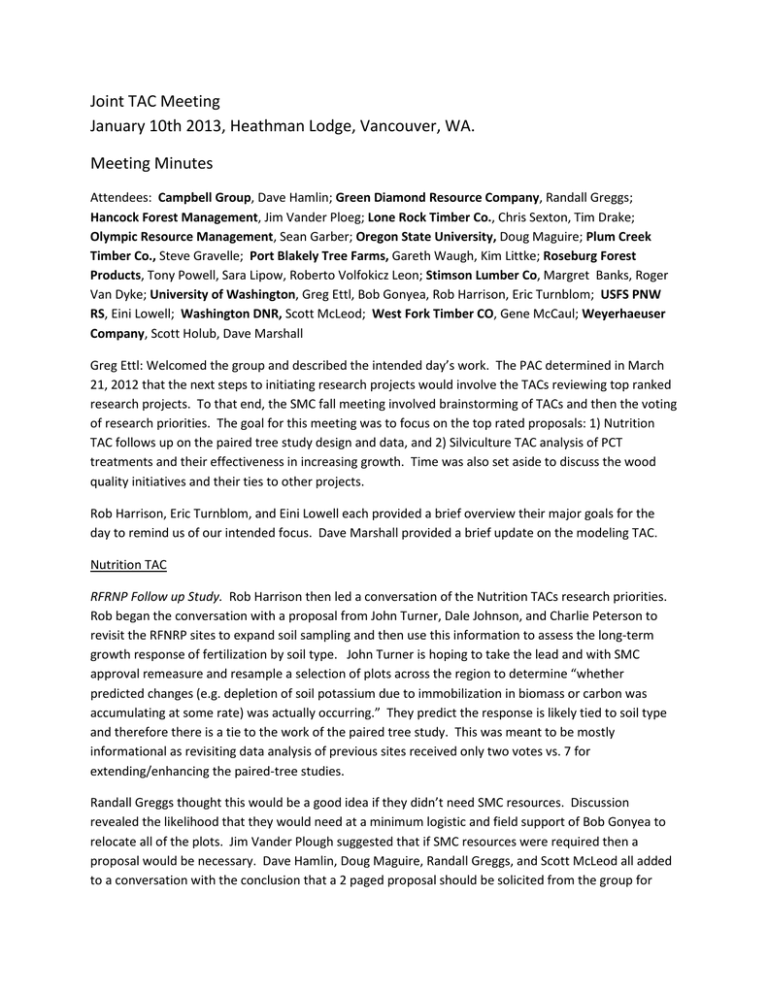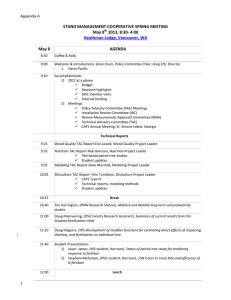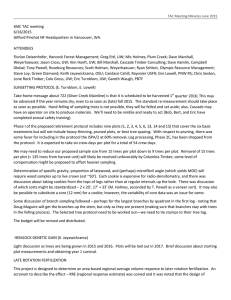Joint TAC Meeting January 10th 2013, Heathman Lodge, Vancouver, WA. Meeting Minutes
advertisement

Joint TAC Meeting January 10th 2013, Heathman Lodge, Vancouver, WA. Meeting Minutes Attendees: Campbell Group, Dave Hamlin; Green Diamond Resource Company, Randall Greggs; Hancock Forest Management, Jim Vander Ploeg; Lone Rock Timber Co., Chris Sexton, Tim Drake; Olympic Resource Management, Sean Garber; Oregon State University, Doug Maguire; Plum Creek Timber Co., Steve Gravelle; Port Blakely Tree Farms, Gareth Waugh, Kim Littke; Roseburg Forest Products, Tony Powell, Sara Lipow, Roberto Volfokicz Leon; Stimson Lumber Co, Margret Banks, Roger Van Dyke; University of Washington, Greg Ettl, Bob Gonyea, Rob Harrison, Eric Turnblom; USFS PNW RS, Eini Lowell; Washington DNR, Scott McLeod; West Fork Timber CO, Gene McCaul; Weyerhaeuser Company, Scott Holub, Dave Marshall Greg Ettl: Welcomed the group and described the intended day’s work. The PAC determined in March 21, 2012 that the next steps to initiating research projects would involve the TACs reviewing top ranked research projects. To that end, the SMC fall meeting involved brainstorming of TACs and then the voting of research priorities. The goal for this meeting was to focus on the top rated proposals: 1) Nutrition TAC follows up on the paired tree study design and data, and 2) Silviculture TAC analysis of PCT treatments and their effectiveness in increasing growth. Time was also set aside to discuss the wood quality initiatives and their ties to other projects. Rob Harrison, Eric Turnblom, and Eini Lowell each provided a brief overview their major goals for the day to remind us of our intended focus. Dave Marshall provided a brief update on the modeling TAC. Nutrition TAC RFRNP Follow up Study. Rob Harrison then led a conversation of the Nutrition TACs research priorities. Rob began the conversation with a proposal from John Turner, Dale Johnson, and Charlie Peterson to revisit the RFNRP sites to expand soil sampling and then use this information to assess the long-term growth response of fertilization by soil type. John Turner is hoping to take the lead and with SMC approval remeasure and resample a selection of plots across the region to determine “whether predicted changes (e.g. depletion of soil potassium due to immobilization in biomass or carbon was accumulating at some rate) was actually occurring.” They predict the response is likely tied to soil type and therefore there is a tie to the work of the paired tree study. This was meant to be mostly informational as revisiting data analysis of previous sites received only two votes vs. 7 for extending/enhancing the paired-tree studies. Randall Greggs thought this would be a good idea if they didn’t need SMC resources. Discussion revealed the likelihood that they would need at a minimum logistic and field support of Bob Gonyea to relocate all of the plots. Jim Vander Plough suggested that if SMC resources were required then a proposal would be necessary. Dave Hamlin, Doug Maguire, Randall Greggs, and Scott McLeod all added to a conversation with the conclusion that a 2 paged proposal should be solicited from the group for review by the Nutrition TAC and approval of the PAC before any work is initiated. The suggestion was for 2 versions of the proposal: a) full proposal costs, and b) stripped down version that would get us started. Since the group expressed almost universal opinions that this would only be secondary, the Nutrition TAC is not going to develop an RFP on this effort but instead focus their efforts on the extending/enhancement of the paired-tree study. Paired-tree Study. Rob next led a discussion of the paired plot study design and treatments. He emphasized that the paired-tree design allowed for determination of response vs. no response, but was not designed to determine magnitude of response. The conversation first addressed potential holes in our data set. Kim Littke suggested the biggest geographic holes are likely in OR. Doug Maguire indicated there were 16 sites on the OR coast but we might have needs to expand inland. There was agreement that some of the holes in the data are likely due to holes in land coverage (gaps in ownership), or in the lack of receptivity of some members to install the paired-tree plots on their land. It was determined that some members would like to have a few more paired-tree plots on their land should we decide to expand the geographic coverage. There were other members who suggested we had already covered what we needed to and that it is likely we have achieved what we intended with the design—we have a sense of responding vs. non-responding sites. There was additional conversation on potential holes in the data before we shifted the focus to how we can use the responding sites as locations for fixed plots that would allow us to assess the level of response. The most logical next step for the paired-tree research was discussed as being able to link fixed area plots that are sufficiently close to the responding paired tree study plots that we could determine the level of the response. A general strategy could include installing (or locating existing) fixed area plots adjacent to the paired-tree responders. It was suggested that we might select 2-3 plots of low, medium, and high responding sites. The non-responders would be eliminated from fixed plot considerations. The goal (hope?) would then be that there would be a trend in the response which would allow interpolation of fertilization response for the majority of the responding sites. Some of the most difficult challenges of installing fixed area plots are deciding where to put them since they will likely be large in area compared to the paired-tree installation, and how many are needed to provide a cost-efficient decision on fertilization. A good step would be to identify some plots that would allow some initial tests. There was considerable discussion as to how we should invest in these installations including the number of plots needed, and the size of the plots. There was concern that the controls would need to be of sufficient distance (with plot buffers) from the fertilized plots that there would not be overlap of fertilization to controls through presumed widespread root networks, but not so far that site would be different in other respects. An ideal scenario would be to have some existing fixed area plots near the paired tree plots so we wouldn’t have to go through the expense of new installations. Bob Gonyea remembered (just after the meeting) that “…we already have 2 Type V installations with "fixed area" plots in the same stand and immediately adjacent to the single tree installation. Installations #845, Hanes Ranch and #893, Frozen Creek. Sean Garber, then with Roseburg Timber, showed me the sites and wanted the individual tree studies next to the fixed plot installations they had already installed in the stand.” These plots provide one opportunity to test the idea that we can use a matched fixed area plot to the paired-tree plots in order to determine the magnitude of response. It was agreed that the next step is for Rob Harrison to create a Request for Proposal document that will highlight the research needs for this next step in using the paired-tree data. Silviculture TAC Eric Turnblom initiated the conversation on constructing a RFP for an analysis of PCT in the Type I and III stands in order to determine the relative response of stands of differing initial stocking and/or respacing. The conversation began with a reminder of the initial plot design and thinning treatments. The thinning treatments in the Type III installations were designed by the Silviculture TAC to follow Wilson’s Spacing Index (Relative Spacing target of 0.17 and 0.27). Therefore the response of the stands to these thinnings will be useful in determining the future trajectories of the stands under very early and more conventionally timed entries. There was some initial confusion among the members as to how or why this idea was the highest ranked research priority. The group determined that one of the most important reasons for this analysis was to compare future stand trajectories with and without thinning. Further, the usual question of what density to use to deliver the most volume in the shortest time has become nuanced, so that nowadays many silviculturists are asking what are the most profitable markets for the materials this stand might produce and what are the PCT specifications that will most probably produce the optimum product mix, given the current state of the stand. The SMC database is well-suited to comparing various timings and intensities of precommercial thinning (early spacing) and subsequent thinning with unthinned plots at various initial stockings. The output will be useful for growth modeling (e.g., refining ORGANON), examining impacts on wood quality, comparing the potential array of log sorts under differing trajectories. Each member will likely want input into the metrics as the outputs will inform their current internal decision making processes. It was generally agreed that although many thin, evidence of the benefits of thinning could support bottom-line considerations. It was agreed that Eric would draft a Request for Proposals for the PCT analysis. That will then be circulated among the Silviculture TAC members for comment. Wood Quality TAC Eini Lowell led a conversation regarding the wood quality proposals that were discussed at the SMC fall meeting. Eini first noted that none of the wood quality proposals were on the top of people’s lists. Still, most members remain interested in wood quality and so we discussed ways that we might tie wood quality projects to other active research projects. Eini proposed that wood quality measures could be integrated into future research proposals. The group identified one immediate opportunity for some wood quality work. A previous Agenda 2020 proposal indicated we would be comparing wood density with fertilization. We have the opportunity to complete this part of the research by taking samples when thinning treatments are implemented; Doug Maguire has a thinning planned where samples for this purpose may be gathered. There is also an opportunity to collect wood samples as the paired-tree studies mature. We concluded that we should look for opportunities to take some wood quality data as soon as possible so that we can move forward some aspects of the Agenda 2020-related projects. Eini is to draft a Request for Proposals that will meet the needs of getting some wood quality data soon, preferably by piggybacking on another study. Installation and Sunsetting Review Committee We briefly discussed the follow up steps to the meeting we had in the spring to discuss current installations and plans for potentially sunsetting some installations. We agreed that we need to develop a protocol for sunsetting the Type I installations. The Installation Review Committee should meet again to discuss options for redeploying these plots as carryover studies, and/or collecting wood quality data. Modeling TAC Dave Marshall provided a brief update on the modeling TAC. The highest current priority is examining the Type I and III growth model fits. This is a priority project for Eric Turnblom. There was also discussion of modeling thinned and unthinned growth responses in ORGANON. Currently, Doug Maguire, under the auspices of the Center for Intensive Plantation Silviculture, is collaborating with Rob Harrison and Eric Turnblom to update the thinning- and fertilization-response models contained in SMCORGANON to take advantage of the additional SMC measurement data that has been collected since the last time those models were updated.






